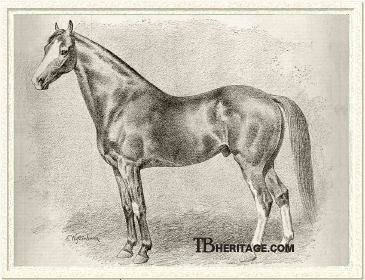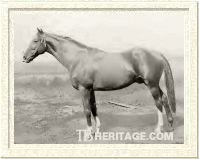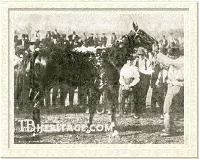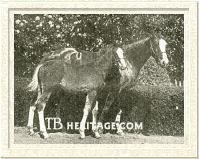|
|
Joe Hooker

|
|
 |
|
|
The blaze-faced chestnut Joe Hooker was rescued from obscurity by the influential California breeder Theodore Winters, who owned the champion colt Norfolk and bred his outstanding son, Emperor of Norfolk, among many other top race horses of the late nineteenth century, both in California and in "the east."
Joe Hooker was bred in California by Adolph Mailliard, who brought both Monday and Mayflower to his new farm in Marin County, California, from his Bordentown, New Jersey stock farm in 1870. Joe Hooker's sire, Monday, was a grandson, in tail-male, of Lexington, and both he and Joe Hooker's dam, Mayflower, were loaded with classic American racing names in their pedigrees. Monday won the Jersey Derby, beating the great filly Ruthless, and the Sequel Stakes, beating Virgil, but broke down in the first running of the Belmont Stakes (won by Ruthless). He was among the leading sires in California, getting a number of good stakes winners; his most famous offspring was the California champion mare, Mollie McCarty, about whom songs were written.
Joe Hooker was a bright chestnut with a wide-blzed face and some irregular white markings, including a patch on his near fore knee, and a hind stocking that trailed up his leg almost to his gaskin. He eventually grew to 16 hands in height. He was named after "fighting Joe Hooker," the civil war hero stationed in northern California in the 1850s, who, as a military officer, had participated in racing, and also dabbled in northern California politics.
Joe Hooker was sold to trainer Wilbur Pierce, and showed tremendous speed; turf writer Thomas Merry later said, "We will die in the belief that he [Joe Hooker] was the fastest horse ever saddled on a California track if he would have run kindly. We once saw him sulk and 'prop' himself three times in a mile, and then lap out Bradley in the excellent time of 1:45." However, he was badly mismanaged at age two: he was mostly unschooled, and occasionally ridden by a young boy who would ride him to the end of the lane and then turn him and let him run all-out for home. When a "professional" attempted to break him of this habit of racing for home by beating him "unmercifully," he temper was spoiled and his desire to run for anyone ruined. At age three he ran a few times for his new owner, R. Harvey, but proved useless, refusing to cooperate with his jockeys, and he was sold on to a saddle horse dealer, and from him to "gypsies."
A probably apocryphal story tells us that Theodore Winters spotted Joe Hooker being dragged behind a cart near his Rancho del Arroyo farm, close to what would become the town of Winters, California, and bought him on the spot, only later discovering who the horse actually was, having only identified him immediately as a blood horse. Joe Hooker was four years old, in miserable shape, and just as uncooperative as he had been when running. Winters had him schooled by an old-time horseman, which improved his tractability, and also his condition. However he came into Winters' hands, Winters bred him to four mares at Rancho del Arroyo in 1877: Puss, Laura Barnes and Queen, all thoroughbred daughters of Norfolk, and Big Gun (a.k.a. Kate George), by Old George, a grade mare that had a "dash of Oregon quarter-horse strain." After this first season, Joe Hooker was sent to Winters' Rancho Del Sierras acreage in Nevada's Washoe Valley, where fleet range foals with blaze faces, out of grade mares, began appearing on the ranch.
In 1881, NEVA WINTERS (named for Winters' daughter), out of Queen, won two of her three starts. FRED COLLIER, out of Puss, won five of his twelve starts at age three, including three of the most prestigious races of the time in the west: the Fame Stakes and Handicap Sweepstakes at San Francisco, the Capital Hotel Stakes at Sacramento, and the Gazette Stakes at Eureka, Nevada; at age four he won five of his ten races, including the Post Stakes at Sacramento, and at age five he won the Pacific Cup at Oakland and two other races in his seven starts. JIM RENWICK, out of the grade mare Big Gun, would later became a well-known name on the western turf, winning the Hearst Stakes and Hard Luck Stakes in San Francisco at age four, and at age five, winning eleven of his fifteen starts, including the Night Hawk Stakes in Sacramento, the Flash Stakes at San Francisco, and other big races on the west coast. He was sold on to G.M. Buchanan who successfully ran him in the East at ages six and seven.
After his Rancho del Arroyo thoroughbred youngsters began to win in 1881, Winters had Joe Hooker rounded up, and sent to his Rancho del Rio stud just south of Sacramento, California, where the aging Norfolk was standing; Joe Hooker could do double-duty there, as a supplemental stallion to Norfolk and as a cross on Norfolk's daughters. Joe Hooker proved to be a superior sire of race horses, many of which excelled well beyond the isolated west coast venues, but like so many of Lexington's progeny, the contributions of those not gelded to the stud book were severely affected, both by the British Jockey Club's 1913 Jersey Act, which excluded Lexington descendants due to their "impure" blood, and by the progressive reform movement at the end of the first decade of the twentieth century, when racing in America was severely curtailed. Joe Hooker died at Winters' Rancho del Rio farm in 1895 at age 23.
Among Joe Hooker's notable progeny were:
The gelded BONANZA (1882) was out of Mattie Glenn, by imported Glen Athol, who was bred by A.J. Alexander of Woodburn Stud in Kentucky, and sold to Winters and shipped to his Winters stud farm, later moved to Rancho del Rio. Winters sold Bonanza to J.D. Christy as a yearling and he was shipped back east to run. At age two he ran second in the Thames Stakes at Lexington, and then won the Sanford Stakes at Lousville beating top juveniles over a muddy track. At age three he travelled all over the east, and won six of his twenty-eight races, including the Battle House Purse at Mobile, the McConnico Stakes at New Orleans, and a sweepstakes at Coney Island. In his next season he won five of his forty races, including two Freed Handicap Sweestakes at Monmouth Park in New Jersey, and several other handicaps in New York, in one coming from ten lengths behind to win.
ICHI BAN (1882) was a grey colt out of the Norfolk daughter Queen of Norfolk, herself a good racehorse that won in the east. He was sold to J.B. Haggin, whose Rancho del Paso north of Sacramento was supplemented by a number of Winters-bred horses. Like Bonanza, he was gelded. At age three he won five of his twelve starts, including the Shafter Stakes in Sacramento, and the following year the Flash Stakes, also at Sacramento. He was sold on to A. Ohrens, and shipped east, where he won at Jerome Park in New York.
C.H. TODD (1884), was out of Rosa B., by Norfolk. He was purchased as a yearling at Winters' 1885 sale by Dan McCarty, a novice to racing; C.H. Todd was his one-horse stable. C.H. Todd won four of his seventeen races as a juvenile, including the San Jose and Gilroy Stakes at San Jose, and a $500 purse at Stockton, where he beat three good horses in the fastest mile (1:41-1/2) run in California to that time. At age three he won a sweepstakes in Sacramento, while McCarty was deciding to nominate him for the prestigious American Derby, and J.B. Haggin agreed to include C.H. Todd in a shipment of Haggin horses bound east. Going off at odds of 30-1, he beat a top field of thirteen other horses, including Lucky Baldwin's Miss Ford, Terra Cotta, Goliah, and other horses that had gathered from all over the country to compete for racing's richest purse. |

Don José
| | DON JOSE (1886, out of Countess Zeika by Norfolk) was bred and raced by Winters, a flashy chestnut like his sire, that stood 16 hands. He was a top juvenile in California, winning four of his seven starts. He would have won his maiden race, the California Stakes at San Francisco, coming home "a sure winner," when he jumped the fence 30 yards from the finish, in the process trampling and killing a bystander. After that he won a 3/4 mile dash at Oakland, and the next day took the Golden Gate Stakes (7/8 mile) carrying 116 pounds. At Reno he was beaten by his chief rival in the west, Almont, in the Nevada Stakes (3/4 mile). A week later he was at the Sacramento State Agricultural Fair, where he won the Introduction Stakes (3/4 mile) beating a huge field that included Almont, and two other Winters entries, Barham (by Norfolk), and The Czar (by Norfolk), the latter considered even better than Don Jose. Three days later he was second to Almont in the California Annual Stakes for Two-Year-Olds (1 mile) run in a fast 1:17. In November, his last race of the season, he beat Almont, SORRENTO, Flood, and the other top juveniles of the year in the Autumn Stakes at the San Francisco Blood Horse Association.
|
In May of 1890 Winters shipped eight horses, including DON JOSE and The Czar and the juvenile El Rio Rey to St. Louis to begin their eastern campaign. The Czar died of strangles enroute, a great loss, but El Rio Rey won big races at St. Louis, Chicago and New York. Don Jose did not fare so well. Sent back to California for the winter, the horses were shipped to Nashville in February of 1891 to start the eastern season. El Rio Rey developed a serious lung infection, and had to be retired and sent back to California, and Winters' latest sensation, Rey Del Rio went amiss. With other troubles and financial difficulties, Winters leased DON JOSE to trainer P. Grogan. In July of that year he sold DON JOSE for $1500 to Samuel Trowbridge who installed the horse at his stud at Belle Meade, New Jersey. He was a moderately successful stallion of mostly juvenile winners.
SORRENTO (1886) was a full brother to C.H. Todd, and also purchased by McCarty. This colt went directly back east to run, and as a juvenile won the July Stakes and the Free Handicap Sweepstakes at Monmouth, beating some very good youngsters, including Tom Ochiltree and Diablo. At age three he won some good races, and at age four ran second to Spokane in the American Derby. |

His great daughter, Yo Tambien

Sonomis (1893, from Blizzard by Blazes), one of his blaze-faced daughters, was bred by Winters. She was a broodmare in the northern California stud of Burns and Waterhouse, where she produced a succesion of winners, the best probably her gelded 1900 colt, Alsono (seen above, by Altamax), a good juvenile winner. She was sold to the Calvada Stud (Fallon Nevada) of H.J. Kinkead when California racing ended.
| |
YO TAMBIEN (1889), was out of Winters' premier broodmare, Marian, who, until Norfolk's death, had only been bred to him. Her first foal by Joe Hooker was Yo Tambien, the "Queen of the Turf" in the 1890s. When Winters sold all horses of racing age preparatory to his final move to his Nevada Ranch, Yo Tambien was shipped to Chicago, where she topped the sales at $17,000, and where from three to six, she stomped the mid-west competition, and those shipped from the east to compete for Chicago purses, including the 1892 Kentucky Derby winner, Azra, in the Garfield Park Derby, and the top colt Lamplighter in a nine-furlong race at Hawthorne. She amassed 44 victories, and retired with earnings of $89,480. Turf historian John Hervey rated her as the greatest distaffer in the U.S. until Busher raced in 1945.
Bred to Hanover in 1895, she was mortally injured in a paddock accident prior to foaling. Other foals from the Joe Hooker-Marian cross included winning colt YO EL REY (owned by San Francisco sportsman Charles Fair) and the unraced REY DEL SIERRAS, who in 1910 produced a colt also named Joe Hooker, that won three races at age three; both these horses became stallions in California.
|
Other good Joe Hooker youngsters included: QUIRT, winner of eight handicaps at San Francisco, Portland, and elsewhere in the west; ZALDIVER, winner in New Orleans, Nashville, Houston, Milwaukee and Windsor, Ont., later also a winner over fences, including a handicap steeplechase at Latonia; THE PEER, a top American steeplechaser who won the Empire City Steeplechase at Morris Park (New York); OREGON ECLIPSE, winner of handicaps at San Francisco, St. Louis and elsewhere.
A Joe Hooker grandson, Sir Walter(1890), won the Great American and Great Eclipse Stakes at Brooklyn, and, at age 6, the Brooklyn Handicap at Gravesend over the noted racehorse Clifford. He beat the great Domino. He ran seven seasons, and retired sound, and was moderately successful as a stallion.
--Patricia Erigero
|
|
|
|

